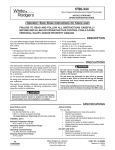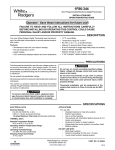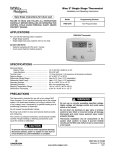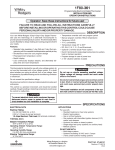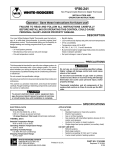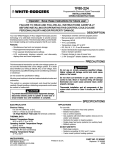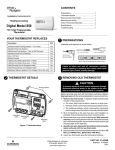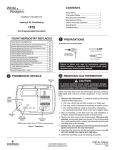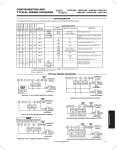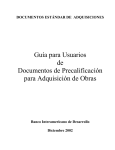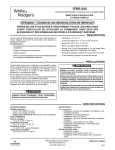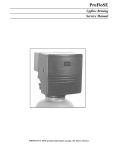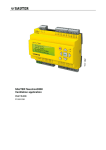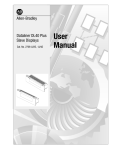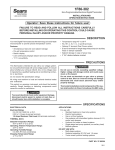Download White Rodgers 1F86-344 Installation and Operation Instructions
Transcript
1F86-344 Non-Programmable Electronic Digital Thermostat INSTALLATION AND OPERATION INSTRUCTIONS Operator: Save these instructions for future use! FAILURE TO READ AND FOLLOW ALL INSTRUCTIONS CAREFULLY BEFORE INSTALLING OR OPERATING THIS CONTROL COULD CAUSE PERSONAL INJURY AND/OR PROPERTY DAMAGE. DESCRIPTION Your new White-Rodgers Digital Thermostat uses the technology of a solid-state microcomputer to provide precise temperature control. Features: • Simultaneous heat and cool setpoint storage • Pre-set temperature control • Backlit display • LCD continuously displays setpoint and room temperature • • • • • °F/°C convertibility Temperature range 45° to 90°F RC, RH, C, W, Y, G , O and B terminals Optional C terminal (Dual Power option) B and O terminals for single stage heat pumps (no auxiliary heat) or damper operation • Setpoint storage in case of power loss • 2 "AA" alkaline batteries included PRECAUTIONS This thermostat is intended for use with a low voltage system; do not use this thermostat with a line voltage system. If in doubt about whether your wiring is millivolt, line, or low voltage, have it inspected by a qualified heating and air conditioning contractor or electrician. Do not exceed the specification ratings. All wiring must conform to local and national electrical codes and ordinances. This control is a precision instrument, and should be handled carefully. Rough handling or distorting components could cause the control to malfunction. ! WARNING Do not use on circuits exceeding specified voltage. Higher voltage will damage control and could cause shock or fire hazard. Do not short out terminals on gas valve or primary control to test. Short or incorrect wiring will damage thermostat and could cause personal injury and/or property damage. Thermostat installation and all components of the system shall conform to Class II circuits per the NEC code. ! CAUTION To prevent electrical shock and/or equipment damage, disconnect electric power to system at main fuse or circuit breaker box until installation is complete. SPECIFICATIONS APPLICATIONS ELECTRICAL DATA Electrical Rating: 8 to 30 VAC 50/60 Hz. or D.C. 0.05 to 1.0 Amps (Load per terminal) 1.5 Amps Maximum Total Load (All terminals combined) THERMAL DATA Setpoint Temperature Range: 45°F to 90°F (7°C to 32°C) Operating Ambient Temperature Range: 32°F to 105°F Operating Humidity Range: 0 to 90% RH (non-condensing) Shipping Temperature Range: -4°F to 150°F For use with: • Standard heat/cool or heat only systems • Electric heat systems • Gas or oil fired systems • Gas systems with intermittent ignition devices (I.I.D.) and/or vent dampers • Hydronic (hot water or steam) systems • Single-stage heat pump systems (no auxiliary heat) • Millivolt systems DO NOT USE WITH: • Multi-stage systems • Systems exceeding 30 VAC and 1.5 amps • 3-wire zoned hydronic heating systems White-Rodgers is a division of Emerson Electric Co. www.white-rodgers.com PART NO. 37-6585B Replaces 37-6585A 0745 INSTALLATION REMOVE OLD THERMOSTAT Screw anchors 1. Shut off electricity at the main fuse box until installation is complete. Ensure that electrical power is disconnected. 2. Remove the front cover of the old thermostat. With wires still attached, remove wall plate from the wall. If the old thermostat has a wall mounting plate, remove the thermostat and the wall mounting plate as an assembly. 3. Identify each wire attached to the old thermostat using the labels enclosed with the new thermostat. 4. Disconnect the wires from old thermostat one at a time. DO NOT LET WIRES FALL BACK INTO THE WALL. 5. Install new thermostat using the following procedures. Mounting holes ATTENTION! Mounting holes This product does not contain mercury. However, this product may replace a unit which contains mercury. Electric/Gas switch Do not open mercury cells. If a cell becomes damaged, do not touch any spilled mercury. Wearing nonabsorbent gloves, take up the spilled mercury with sand or other absorbent material and place into a container which can be sealed. If a cell becomes damaged, the unit should be discarded. Figure 1. Thermostat Base 6. Push excess wire into wall and plug hole with a fire-resistant material (such as fiberglass insulation) to prevent drafts from affecting thermostat operation. Mercury must not be discarded in household trash. When the unit this product is replacing is to be discarded, place in a suitable container and return to White-Rodgers at 2895 Harrison Street, Batesville, AR 72501-2117 for proper disposal. BATTERY LOCATION 2 "AA" alkaline batteries are included in the thermostat at the factory with a battery tag to prevent power drainage. You must remove the battery tag to engage the batteries. ELECTRIC HEAT OR SINGLE-STAGE HEAT PUMP SYSTEMS If "LO BATTERY" is displayed, the batteries are low and should be replaced. For best results, replace all batteries with new premium brand alkaline batteries such as Duracell® or Energizer®. To replace batteries, install the batteries along the top of the base (see Fig. 1). The batteries must be installed with the positive (+) end to the left. This thermostat is configured from the factory to operate a heat/ cool, fossil fuel (gas, oil, etc.), forced air system. It is configured correctly for any system that DOES NOT require the thermostat to energize the fan on a call for heat. If your system is an electric heat or heat-pump system that REQUIRES the thermostat to turn on the fan on a call for heat, locate the GAS/ELECTRIC switch on the back of the thermostat (see fig. 1) and switch it to the ELECTRIC position. This will allow the thermostat to energize the fan immediately on a call for heat. If you are unsure if the heating/cooling system requires the thermostat to control the fan, contact a qualified heating and air conditioning service person. HYDRONIC (HOT WATER OR STEAM) HEATING SYSTEMS This thermostat is set to operate properly with a forced-air heating system. If you have a hydronic heating system (a system that heats with hot water or steam), you must set the thermostat to operate properly with your system. Change the second option in the configuration menu to SL (see CONFIGURATION MENU, page 4). ATTACH THERMOSTAT BASE TO WALL 1. Remove the packing material from the thermostat. Gently pull the cover straight off the base. Forcing or prying on the thermostat will cause damage to the unit. If necessary, move the electric heat switch (see ELECTRIC HEAT SYSTEMS, above). 2. Connect wires beneath terminal screws on base using appropriate wiring schematic (see figs. 2 through 7). 3. Place base over hole in wall and mark mounting hole locations on wall using base as a template. 4. Move base out of the way. Drill mounting holes. 5. Fasten base loosely to wall, as shown in fig. 1, using two mounting screws. Place a level against bottom of base, adjust until level, and then tighten screws. (Leveling is for appearance only and will not affect thermostat operation.) If you are using existing mounting holes, or if holes drilled are too large and do not allow you to tighten base snugly, use plastic screw anchors to secure subbase. CHECK THERMOSTAT OPERATION If at any time during testing your system does not operate properly, contact a qualified service person. Turn on power to the system. Fan Operation If your system does not have a G terminal connection, skip to Heating System. 1. Move FAN switch to ON position. The blower should begin to operate. 2. Move FAN switch to AUTO position. The blower should stop immediately. 2 JUMPER WIRE C‡ THERMOSTAT C‡ B Y O G W RC THERMOSTAT B G W RC RH SYSTEM RH SYSTEM Fan Relay Y O Heating System Cooling System Fan Relay Hot Heating System 24 VAC 120 VAC Neutral Hot 24 VAC NOTE HEATING TRANSFORMER 120 VAC Neutral For 2-wire Heat only, attach to RH and W Hot TRANSFORMER 24 VAC Figure 2. Typical wiring diagram for heat only, 3-wire, single transformer systems 120 VAC Neutral COOLING TRANSFORMER Figure 5. Typical wiring diagram for heat/cool, 5-wire, two-transformer systems JUMPER WIRE C‡ THERMOSTAT B O Y G W RC RH SYSTEM Cooling System JUMPER WIRE Fan Relay Hot 24 VAC C‡ JUMPER WIRE THERMOSTAT B Y O G W RC RH SYSTEM 120 VAC Neutral Reversing Compressor Fan Valve* Contactor Relay TRANSFORMER Figure 3. Typical wiring diagram for cool only, 3-wire, single transformer systems Hot 24 VAC * Reversing valve is energized when the system switch is in the COOL position 120 VAC Neutral TRANSFORMER Figure 6. Typical wiring diagram for heat pump with reversing valve energized in COOL NOTE RED jumper wire (provided with thermostat) must be connected between thermostat RH and RC terminals for proper thermostat operation with this system. C‡ JUMPER WIRE JUMPER WIRE THERMOSTAT B O Y G W RC JUMPER WIRE RH SYSTEM C‡ THERMOSTAT B O Y G W RC RH SYSTEM Cooling System Fan Relay Heating System Reversing Compressor Fan Valve* Contactor Relay Hot 24 VAC 120 VAC * Reversing valve is energized when the system switch is in the HEAT position Neutral TRANSFORMER 120 VAC Neutral TRANSFORMER Figure 7. Typical wiring diagram for heat pump with reversing valve energized in HEAT Figure 4. Typical wiring diagram for heat/cool, 4-wire, single transformer systems ‡ Hot 24 VAC The 24 Volt neutral connection to terminal C on the thermostat is not required if the batteries are replaced once a year with fresh premium brand alkaline batteries. Cooling System Heating System 1. Move SYSTEM switch to HEAT position. If the heating system has a standing pilot, be sure to light it. ! CAUTION 2. Press to adjust thermostat setting above room temperature. The heating system should begin to operate. To prevent compressor and/or property damage, if the outdoor temperature is below 50°F, DO NOT operate the cooling system. 3. Press to adjust temperature setting below room temperature. The heating system should stop operating. 1. Move SYSTEM switch to COOL position. 2. Press to adjust thermostat setting below room temperature. The blower should come on immediately on high speed, followed by cold air circulation 3. Press to adjust temperature setting above room temperature. The cooling system should stop operating. 3 OPERATION Before you begin using your thermostat, you should be familiar with its features and with the display and the location and operation of the thermostat buttons. Your thermostat consists of two parts: the thermostat cover and the base. To remove the cover, pull it straight out from the base. To replace the cover, line up the cover with the base and press until the cover snaps onto the base. The Thermostat Buttons and Switches (see fig. 8) 1 Raises temperature setting. 2 Lowers temperature setting. 3 FAN switch (ON, AUTO). F 4 SYSTEM switch (COOL, OFF, HEAT). C BATTERY The Display 9 5 Flame icon ( ) is displayed when the SYSTEM switch is in the HEAT position. Snowflake icon ( )is displayed (nonflashing) when the SYSTEM switch is in the COOL position. Snowflake is displayed (flashing) if the thermostat is in lockout mode to prevent the compressor from cycling too quickly. FILTER 8 5 7 6 5 Figure 8. Thermostat display, buttons, and switches CONFIGURATION MENU The configuration menu allows you to set certain thermostat operating characteristics to your system or personal requirements. 6 Displays current temperature. 7 Displays "FILTER" when the system has run for the selected filter time period as a reminder to change or clean your air filter. Move SYSTEM switch to the OFF position, then press and at the same time to enter the configuration menu. The display will show the first item in the configuration menu. 8 Displays set point temperature (this is blank when SYSTEM switch is in the OFF position). The configuration menu chart below summarizes the configuration options. An explanation of each option follows. 9 Displays "BATTERY" and "LO" in the current temperature location when the 2 "AA" batteries are low and should be replaced. Press and to change to the next menu item. To exit the menu, move the SYSTEM switch to HEAT or COOL. If no keys are pressed within fifteen minutes, the thermostat will exit the configuration menu. Configuration Menu Step Press Button(s) 1 Set SYSTEM switch to OFF 2 Displayed (Factory Default) Press or to select: SYSTEM switch must be OFF to configure thermostat options SL and COMMENTS Select FA or SL (Fast or Slow) heating cycle rate (FA) 3 and d-L (ON) OFF Select display backlight OFF or ON 4 and FILTER (000) 0 to 1950 hours (in 50 hour increments) Select Filter replacement run time 5 and LOC (OFF) ON 6 and 0 HI (0) 4 LO to 4 HI 7 and (F) C 8 Set SYSTEM switch to HEAT or COOL * Press and Select Compressor lockout OFF or ON Select temperature display adjustment higher or lower Select temperature display to F or C Returns to normal operation to advance to next item 4 2) Select FA or SL (Fast or Slow) Heating Cycle Rate - The FA setting is frequently used for gas, oil or electric heat. The SL setting produces a longer heating cycle which is normally for hot water or steam (hydronic) systems. Both settings produce very accurate temperature control and can be set to your personal preference. FA cycles the system just under 1°F and the SL setting cycles at approximately 1.5°F. 3) Select Display Backlight (d-L OFF or ON) - The display backlight improves display contrast in low lighting conditions. Selecting backlight ON will keep the light on for a short period of time after any key is pressed. Selecting OFF will keep the light off. 4) Select filter replacement run time - The thermostat will display "FILTER" after the selected time of operation. This is a reminder to change or clean your air filter. This time can be set from 0 to 1950 hours in 50 hour increments. A selection of 000 will cancel this feature. When "FILTER" is displayed, you can clear it by pressing SETTING THE THERMOSTAT This thermostat is very easy to operate. Set the SYSTEM switch or until the to either HEAT or COOL then press temperature you want to maintain is shown on the right side of the display. If you want to turn the system off, just move the SYSTEM switch to OFF. The FAN switch controls the fan operation. When the FAN switch is set to AUTO, the fan will cycle with the furnace or air conditioner. When the FAN switch is set to ON, the fan will run continuously, regardless of SYSTEM switch position. TROUBLESHOOTING No Heating With the SYSTEM switch set to HEAT, when the setpoint temperature is raised or lowered past the room temperature, the thermostat will make a soft click sound. Usually, the sound indicates the thermostat is operating correctly. If the system does not come on, check the system or contact your heating/ cooling service person. If the thermostat does not click try the Reset Operation listed below. and at the same time. This resets the timer and starts counting the hours until the next filter change. 5) Select Compressor Lockout (LOC OFF or ON) - Selecting LOC ON will cause the thermostat to wait 5 minutes before turning on the compressor if the heating and cooling system loses power. It will also wait 5 minutes minimum between cooling cycles. This is intended to help protect the compressor from short cycling. Some newer compressors already have a time delay built in and do not require this feature. Your compressor manufacturer can tell you if the feature is already present in their system. When the compressor time delay occurs it will flash the (snowflake icon) for about five minutes then turn on the compressor. 6) Select Temperature Display Adjustment (4 LO to 4 HI) Allows you to adjust the room temperature display 4° higher or lower. Your thermostat was accurately calibrated at the factory but you have the option to change the display temperature to match your previous thermostat. 7) Select Temperature DIsplay (°F or °C) - Changes the display readout to Celsius or Fahrenheit as required. No Cooling Same procedure as heating except set SYSTEM switch to COOL. There can be up to a 5 minute compressor lock-out time delay before the thermostat clicks in COOL. Blank Display A blank digital display usually indicates the thermostat has received a voltage spike, static discharge or requires new batteries. If the display remains blank after replacing the batteries, see Reset Operation below. Reset Operation If a voltage spike or static discharge blanks out the display or causes erratic thermostat operation you can reset the thermostat by pressing , and move the SYSTEM switch from OFF to HEAT at the same time. This also resets the factory defaults to the configuration menu. If the thermostat has power, has been reset and still does not function correctly contact your heating/cooling service person or place of purchase. OPERATING FEATURES Now that you are familiar with the thermostat buttons and display, read the following information to learn about the many features of the thermostat. • SIMULTANEOUS HEATING/COOLING SETPOINT STORAGE — You can enter both your heating and cooling set points at the same time. There is no need to change the thermostat at the beginning of each season. • CONFIGURATION MENU — Allows you to customize certain thermostat options. 5 HOMEOWNER HELP LINE: 1-800-284-2925 The Emerson logo is a trademark and service mark of Emerson Electric Co. St. Louis, Missouri Markham, Ontario www.white-rodgers.com 1F86-344 Termostato digital electrónico no programable INSTRUCCIONES DE INSTALACIÓN Y OPERACIÓN Sr. operador: ¡Conserve estas instrucciones para consultarlas en cualquier momento! EL NO LEER Y SEGUIR CON CUIDADO TODAS LAS INSTRUCCIONES ANTES DE INSTALAR O UTILIZAR ESTE CONTROL PODRÍA CAUSAR LESIONES PERSONALES Y/O DAÑOS MATERIALES. Su nuevo termostato digital de White-Rodgers utiliza la tecnología de una microcomputadora de estado sólido para proporcionar un control preciso de la temperatura. Características: • Almacenamiento simultáneo de temperatura de referencia de calefacción y refrigeración • Control de temperatura pre-definida • Pantalla con luz de fondo • La pantalla de LCD muestra de forma permanente la temperatura de referencia y la temperatura ambiente DESCRIPCIÓN • Convertibilidad de°F a °C • Rango de temperatura de 45° a 90°F • Terminales RC, RH, C, W, Y, G, O y B • Terminal C opcional (opción de doble alimentación) • Terminales B y O para bombas de calor de una sola etapa (sin calor auxiliar) u operación de amortiguación • Almacenamiento de temperatura de referencia en caso de cortes de energía eléctrica • Incluye 2 pilas alcalinas “AA” PRECAUCIONES Este termostato está diseñado para ser utilizado con un sistema de bajo voltaje; no utilice este termostato con un sistema de voltaje de línea. Si tiene dudas acerca de si su conexión eléctrica es milivoltio, de línea o de bajo voltaje, hágala inspeccionar por un técnico especializado en equipos de calefacción y aire acondicionado o por un electricista autorizado. No exceda los valores nominales especificados. Todas las conexiones eléctricas deben cumplir con los códigos y reglamentaciones locales y nacionales. Este control es un instrumento de precisión y debe manipularse con cuidado. La manipulación descuidada o la distorsión de los componentes podrían hacer que el control no funcionara correctamente. ! ¡PRECAUCIÓN! ! No utilizar en circuitos que excedan el voltaje especificado ya que los voltajes más altos dañarán el control y pueden causar riesgos de electrocución o incendio. No cortocircuite las terminales de la válvula de gas ni del control principal para probarlos. Un cortocircuito o una conexión incorrecta dañarán el termostato y podrían causar lesiones personales y/o daños materiales. La instalación del termostato y de todos los componentes del sistema debe ajustarse a las normas del código NEC para los circuitos Clase II. Para evitar descargas eléctricas y/o daños al equipo, desconecte la alimentación eléctrica en la caja de fusibles o disyuntores principal hasta que haya finalizado la instalación del sistema. DATOS ELÉCTRICOS Características eléctricas: 8 a 30 VCA 50/60 Hz o CC 0.05 a 1.0 A (carga por terminal) 1.5 A de carga total máxima (todas las terminales combinadas) DATOS TÉRMICOS Rango de temperatura de referencia: 45°F a 90°F (7°C a 32°C) Rango de temperatura ambiente operativa: 32°F a 105°F Rango de humedad operativa: 0 a 90% HR (sin condensación) Rango de temperatura de transporte: -4°F a 150°F ¡ADVERTENCIA! ESPECIFICACIONES APLICACIONES Para utilizar con: • Sistemas de calor/frío o sólo calor estándar • Sistemas de calor eléctricos • Sistemas de gas o aceite • Sistemas de gas con dispositivos de encendido intermitente (I.I.D.) y/o amortiguadores de ventilación • Sistemas hidrónicos (agua caliente o vapor) • Sistemas de bomba de calor de una sola etapa (sin calor auxiliar) • Sistemas milivoltios NO UTILIZAR CON: • Sistemas multietapa • Sistemas que exceden los 30 VCA y 1.5 A • Sistemas de calefacción hidrónicos zonificados de 3 cables White-Rodgers es una división de Emerson Electric Co. www.white-rodgers.com N° DE PIEZA 37-6585B Reemplaza 37-6585A 0745 INSTALACIÓN Anclajes Tarugos plásticos RETIRE EL TERMOSTATO VIEJO 1. Apague la electricidad en la caja de fusibles principal hasta que haya finalizado la instalación. Asegúrese de que la alimentación eléctrica esté desconectada. 2. Retire la cubierta delantera del termostato viejo. Con los cables aún conectados, retire la placa de la pared. Si el termostato viejo tiene una placa de montaje sobre pared, retire el termostato y la placa juntos. 3. Identifique cada uno de los cables conectados al termostato viejo usando las etiquetas incluidas con el nuevo termostato. 4. Desconecte los cables del termostato viejo de a uno a la vez. NO DEJE QUE LOS CABLES VUELVAN A INTRODUCIRSE EN LA PARED. 5. Instale el termostato nuevo siguiendo el procedimiento indicado a continuación. Orificios de montaje Interruptor eléctrico/de gas Figura 1. Base del termostato ¡ATENCIÓN! Este producto no contiene mercurio. No obstante, puede reemplazar una unidad que sí contiene mercurio. No abra las celdas de mercurio. En el caso de que una celda se dañe, no toque el mercurio derramado. Usando un par de guantes no absorbentes, recoja el mercurio derramado con arena u otro material absorbente y viértalo en un recipiente que pueda sellarse. Si se daña una celda, debe desecharse la unidad. El mercurio no debe desecharse con los residuos domésticos. Para desechar la unidad que será reemplazada por este equipo, colóquela en un recipiente adecuado y envíela a White-Rodgers a 2895 Harrison Street, Batesville, AR 72501-2117 para su eliminación adecuada. 6. Empuje el cable que sobresale hacia el interior de la pared y tape el orificio con un material ignífugo (como aislamiento de fibra de vidrio) para evitar que las corrientes de aire afecten el funcionamiento del termostato. UBICACIÓN DE LAS PILAS El termostato viene de fábrica con 2 pilas alcalinas “AA” unidas entre sí para evitar que se descarguen. Debe retirar la tira de papel para poder enganchar las pilas en su lugar. Si aparece el mensaje "LO BATTERY", significa que las pilas tienen poca carga y deben cambiarse. Para obtener resultados óptimos, cambie todas las pilas por pilas alcalinas nuevas de alguna marca líder como Duracell® o Energizer®. Para cambiar las pilas, instálelas a lo largo de la parte superior de la base (vea la figura 1). Las pilas deben instalarse con los polos positivos (+) hacia la izquierda. SISTEMAS DE CALOR ELÉCTRICOS O DE BOMBA DE CALOR DE UNA SOLA ETAPA Este termostato está configurado de fábrica para operar un sistema de aire forzado con combustible fósil (gas, aceite, etc.) de calor/frío. Está correctamente configurado para cualquier sistema que NO requiera que el termostato energice el ventilador en una llamada de calor. Si su sistema es un sistema eléctrico o de bomba de calor que REQUIERE que el termostato encienda el ventilador en una llamada de calor, ubique el interruptor GAS/ELECTRIC (vea la figura 1) y colóquelo en la posición ELECTRIC. Esto permitirá al termostato energizar el ventilador inmediatamente en una llamada de calor. Si no está seguro si el sistema de calefacción/refrigeración requiere que el termostato controle el ventilador, póngase en contacto con un servicio técnico de calefacción y aire acondicionado calificado. SISTEMAS DE CALEFACCIÓN HIDRÓNICOS (AGUA CALIENTE O VAPOR) Este termostato está configurado para funcionar en forma adecuada con un sistema de calefacción de aire forzado. Si tiene un sistema de calefacción hidrónico (un sistema que genera calor con agua caliente o vapor), debe configurar el termostato para que funcione de manera adecuada con su sistema. Cambie la segunda opción en el menú de configuración a SL (vea el MENÚ DE CONFIGURACIÓN en la página 4). FIJE LA BASE DEL TERMOSTATO A LA PARED 1. Retire el material de embalaje del termostato. Tire suavemente de la cubierta para separarla de la base. Si fuerza o hace palanca sobre el termostato dañará la unidad. Si es necesario, mueva el interruptor de calor eléctrico (vea la sección SISTEMAS DE CALOR ELÉCTRICOS más arriba). 2. Conecte los cables que se encuentran debajo de los tornillos terminales a la base consultando el esquema de conexiones apropiado (vea las figuras 2 a 7). 3. Coloque la base sobre el orificio de la pared y marque las ubicaciones de los orificios de montaje usando la base como plantilla. 4. Mueva la base a un lado. Perfore los orificios de montaje. 5. Fije la base a la pared sin ajustarla demasiado, como muestra la figura 1, usando dos tornillos de montaje. Coloque un nivel contra la parte inferior de la base, ajústela hasta que quede bien nivelada y luego apriete los tornillos. (Esto es por razones estéticas solamente y no afectará el funcionamiento del termostato.) Si utiliza los orificios de montaje existentes, o si los orificios perforados son demasiado grandes y no le permiten ajustar bien la base, use anclajes plásticos para fijar la subbase. Orificios de montaje VERIFIQUE EL FUNCIONAMIENTO DEL TERMOSTATO Si en algún momento durante la prueba su sistema no funciona correctamente, póngase en contacto con un servicio técnico calificado. Encienda la alimentación del sistema. Funcionamiento del ventilador Si su sistema no tiene una conexión terminal G, pase directamente a la sección Sistema de calefacción. 1. Mueva el interruptor FAN a la posición ON. El soplador debería comenzar a funcionar. 2. Mueva el interruptor FAN a la posición AUTO. El soplador debería detenerse inmediatamente. 2 C‡ CABLE DE PUENTE C‡ B Y O G Relé del ventilador W RC RH G W RC Relé Sistema Sistema del de de refrigeración ventilador calefacción TERMOSTATO G W RC Sistema Relé de del refrigeración ventilador RH Vivo 120 VCA VAC Neutro 120 VAC VCA Vivo 24 VAC VCA 120 VCA Neutro Figura 2. Diagrama de conexiones típico para sistemas de sólo calor de un solo transformador y 3 cables Y TERMOSTATO TRANSFORMADOR DE CALEFACCIÓN TRANSFORMADOR CABLE DE PUENTE SISTEMA 24 VAC VCA Neutro Para sólo calor con 2 cables, conectar a RH y W O RH Vivo 24 VAC VCA B Y O SISTEMA Sistema de calefacción NOTA C‡ B TRANSFORMADOR DE REFRIGERACIÓN Figura 5. Diagrama de conexiones típico para sistemas de calor/frío de dos transformadores y 5 cables SISTEMA TERMOSTATO CABLE DE PUENTE C‡ Vivo 24 VAC VCA 120 VCA Neutro TRANSFORMADOR Figura 3. Diagrama de conexiones típico para sistemas de sólo frío de un solo transformador y 3 cables O Y G Válvula inversora* Contactor del compresor Relé del ventilador B CABLE DE PUENTE W RC RH SISTEMA TERMOSTATO Vivo 24 VCA * La válvula inversora se energiza cuando el interruptor del sistema está en la posición COOL 120 VCA Neutro TRANSFORMADOR Figura 6. Diagrama de conexiones típico para una bomba de calor con válvula inversora energizada en COOL NOTA El cable de puente ROJO (suministrado con el termostato) debe conectarse entre las terminales RH y RC del termostato para que CABLE funcione en forma adecuada con este sistema. DE PUENTE C‡ B O Y G Sistema Relé de del refrigeración ventilador W RC RH Sistema de calefacción CABLE DE PUENTE SISTEMA TERMOSTATO C‡ 120 VAC VCA Y G Contactor del compresor Relé del ventilador W RC * La válvula inversora se energiza cuando el interruptor del sistema está en la posición HEAT Neutro TRANSFORMADOR RH SISTEMA TERMOSTATO Vivo 24 VCA 120 VCA Neutro TRANSFORMADOR Figura 7. Diagrama de conexiones típico para una bomba de calor con válvula inversora energizada en HEAT Figura 4. Diagrama de conexiones típico para sistemas de calor/frío de un solo transformador y 4 cables ‡ O Válvula inversora* Vivo VCA 24 VAC B CABLE DE PUENTE No se requiere la conexión neutra de 24 voltios a la terminal C del termostato si las pilas se cambian una vez al año por pilas alcalinas nuevas de alguna marca líder. Sistema de calefacción Sistema de refrigeración 1. Mueva el interruptor SYSTEM a la posición HEAT. Si el sistema de calefacción tiene un piloto, asegúrese de encenderlo. 2. Presione para ajustar la configuración del termostato por encima de la temperatura ambiente. El sistema de calefacción debería comenzar a funcionar. 3. Presione para ajustar la configuración de la temperatura por debajo de la temperatura ambiente. El sistema de calefacción debería dejar de funcionar. ! ¡PRECAUCIÓN! Para evitar daños al compresor y/o daños materiales, si la temperatura externa está por debajo de los 50°F, NO utilice el sistema de refrigeración. 1. Mueva el interruptor SYSTEM a la posición COOL. para ajustar la configuración del termostato 2. Presione por debajo de la temperatura ambiente. El soplador debería encenderse inmediatamente a alta velocidad, seguido de circulación de aire frío. 3. Presione para ajustar la configuración de la temperatura por encima de la temperatura ambiente. El sistema de refrigeración debería dejar de funcionar. 3 OPERACIÓN Antes de que comience a usar su termostato, debe familiarizarse con sus funciones y con la pantalla y la ubicación y funcionamiento de los diferentes botones. Su termostato consta de dos partes: la cubierta del termostato y la base. Para retirar la cubierta, tire suavemente de ella para separarla de la base. Para volver a colocarla, alinee la cubierta con la base y presione suavemente hasta que se enganche en la base. Los botones e interruptores del termostato (vea la figura 8) Sube el ajuste de temperatura. Baja el ajuste de temperatura. Interruptor FAN (ventilador) (ON, AUTO). Interruptor SYSTEM (COOL, OFF, HEAT). F La pantalla El icono de la llama ( ) aparece cuando el interruptor C BATTERY SYSTEM está en la posición HEAT. El icono del copo de nieve ( ) aparece (fijo) cuando el interruptor SYSTEM está en la posición COOL. El copo de nieve aparece (intermitente) cuando el termostato está en el modo de bloqueo para evitar que el compresor realice ciclos de encendido y apagado demasiado cortos. 9 FILTER 8 5 7 6 5 Figura 8. Pantalla, botones e interruptores del termostato de configuración. La pantalla mostrará la primera opción del menú de configuración. En el cuadro del menú de configuración a continuación se resumen las diferentes opciones de configuración disponibles, seguidas por una explicación de cada una. Muestra la temperatura actual. Muestra "FILTER" cuando el sistema se ha utilizado por la cantidad de tiempo seleccionada en el filtro para recordarle que debe cambiar o limpiar el filtro de aire. y para pasar a la siguiente opción del menú. Presione Para salir del menú, mueva el interruptor SYSTEM a HEAT o COOL. Si pasan quince minutos sin presionar ningún botón, el termostato saldrá del menú de configuración. 1) Seleccione FA o SL (rápida o lenta) para Heating Cycle Rate (velocidad del ciclo de calefacción) - La configuración FA suele utilizarse para sistemas de calefacción de gas, aceite o eléctricos. La configuración SL produce un ciclo de calefacción más largo que lo normal para sistemas de agua caliente o vapor (hidrónicos). Ambas configuraciones producen un control de temperatura sumamente exacto y pueden ajustarse según su preferencia personal. La configuración FA apaga y enciende el sistema debajo de 1°F y la configuración SL lo hace a aproximadamente 1.5°F. Muestra la temperatura de referencia (aparece en blanco cuando el interruptor SYSTEM está en la posición OFF). Muestra "BATTERY" y "LO" en lugar de la temperatura cuando las 2 pilas “AA” tienen poca carga y deben cambiarse. MENÚ DE CONFIGURACIÓN El menú de configuración le permite ajustar ciertas características operativas del termostato según el sistema o sus necesidades particulares. Mueva el interruptor SYSTEM a la posición OFF y luego y al mismo tiempo para ingresar en el menú presione Menú de configuración Paso 1 Presione el botón o botones y 3 4 5 6 7 * Presione Presione o para seleccionar: SL (FA) y d-L (ON) y FILTER (000) y LOC (OFF) ON y 0 HI (0) 4 LO a 4 HI y (°F) OFF Selecciona FA o SL (rápida o lenta) para la velocidad del ciclo de calefacción Selecciona luz de fondo de pantalla OFF (apagada) u ON (encendida) 0 a 1950 horas Selecciona el tiempo de ejecución de reemplazo del filtro (en incrementos de 50 horas) °C Selecciona el bloqueo del compresor en OFF (desactivado) u ON (activado) Selecciona el ajuste de la temperatura visualizada más arriba o más abajo Selecciona la visualización de la temperatura en °F o °C Vuelve al funcionamiento normal Ajuste el interruptor SYSTEM en HEAT o COOL y OBSERVACIONES El interruptor SYSTEM debe estar en OFF para configurar las opciones del termostato Ajuste el interruptor SYSTEM en OFF 2 8 La pantalla muestra (ajustado de fábrica) para pasar a la siguiente opción del menú. 4 AJUSTE DEL TERMOSTATO 2) Seleccione Display Backlight (luz de fondo de pantalla) (d-L OFF [desactivada] u ON [activada]) - La luz de fondo mejora el contraste de la pantalla en condiciones de poca luz. Si selecciona backlight ON, la luz se mantendrá encendida durante un breve tiempo después de presionar cualquier botón. Si selecciona OFF, la luz se mantendrá apagada. 3) Seleccione filter replacement run time (tiempo de ejecución de reemplazo de filtro) - El termostato mostrará “FILTER” después del tiempo de funcionamiento seleccionado. El propósito de este mensaje es recordarle que cambie o limpie el filtro de aire. El tiempo puede ajustarse desde 0 hasta 1950 horas en incrementos de 50 horas. Si elige 000, se cancelará esta función. Cuando y al aparece “FILTER”, puede borrarlo presionando mismo tiempo. De esta manera volverá a cero el reloj y se comenzarán a contar las horas que faltan hasta el siguiente cambio de filtro. 4) Seleccione Compressor Lockout (bloqueo del compresor) (LOC OFF [desactivado] u ON [activado]) Si selecciona LOC ON el termostato esperará 5 minutos para encender el compresor si el sistema de calefacción y refrigeración deja de recibir alimentación eléctrica. También esperará 5 minutos como mínimo entre ciclos de refrigeración para evitar que el compresor realice ciclos de encendido y apagado cortos. Algunos compresores más nuevos ya tienen incorporada una demora de tiempo y no requieren esta función. Consulte al fabricante de su compresor para saber si su modelo incluye con esta función. Cuando se produce la demora de tiempo del compresor, el (icono del copo de nieve) se pone en intermitente durante unos cinco minutos y luego enciende el compresor. 5) Seleccione Temperature Display Adjustment (ajuste de la pantalla de temperatura) (4 LO [más abajo] a 4 HI [más arriba]) - Le permite ajustar la pantalla de temperatura ambiente 4° más arriba o más abajo. El termostato viene calibrado con precisión de fábrica pero usted tiene la opción de cambiar el valor de temperatura que aparece en la pantalla para que coincida con el de su termostato anterior. 6) Seleccione Temperature Display (visualización de temperatura) (F° o C°) - Cambia la unidad en que aparece la temperatura en la pantalla a grados Celsius o Fahrenheit según su preferencia. Este termostato es muy sencillo de operar. Ajuste el interruptor SYSTEM en HEAT o COOL y luego presione o hasta que la temperatura que desea mantener aparezca a la derecha de la pantalla. Si desea apagar el sistema, simplemente mueva el interruptor SYSTEM a la posición OFF. El interruptor FAN controla el funcionamiento del ventilador. Cuando el interruptor FAN se coloca en AUTO, el ventilador se encenderá y se apagará con la caldera o el aire acondicionado. Cuando el interruptor FAN está ajustado en ON, el ventilador funcionará de manera ininterrumpida, independientemente de la posición del interruptor SYSTEM. SOLUCIÓN DE PROBLEMAS El sistema no calienta Con el interruptor SYSTEM ajustado en HEAT, cuando la temperatura de referencia se sube o se baja por encima o debajo de la temperatura ambiente, el termostato emitirá un chasquido suave. Por lo general, el sonido indica que el termostato está funcionando correctamente. Si el sistema no se enciende, verifique el sistema o póngase en contacto con su servicio técnico de calefacción/refrigeración. Si el termostato no emite un chasquido, siga el procedimiento indicado en la sección Operación de reajuste a continuación. El sistema no enfría Siga el mismo procedimiento que para calefacción colocando el interruptor SYSTEM en COOL. Es posible que haya una demora del bloqueo del compresor de hasta 5 minutos antes de que el termostato se active en COOL. La pantalla está en blanco Por lo general, una pantalla digital en blanco indica que el termostato ha recibido un pico de voltaje o una descarga estática o que es necesario cambiar las pilas. Si la pantalla permanece en blanco después de cambiar las pilas, vea la sección Operación de reajuste a continuación. Operación de reajuste Si un pico de voltaje o una descarga estática pone en blanco la pantalla o hace que el termostato funcione de manera errática, puede reajustarlo presionando y y moviendo el interruptor SYSTEM de OFF a HEAT al mismo tiempo. De esta manera, también reajustará los valores predeterminados de fábrica según el menú de configuración. Si el termostato tiene alimentación y se ha reajustado pero aún no funciona correctamente, póngase en contacto con su servicio técnico de calefacción/refrigeración o con el lugar donde realizó la compra. FUNCIONES DEL TERMOSTATO Ahora que está familiarizado con los botones del termostato y la pantalla, lea la siguiente información para conocer las diferentes funciones del termostato. • ALMACENAMIENTO SIMULTÁNEO DE TEMPERATURAS DE REFERENCIA DE CALEFACCIÓN/REFRIGERACIÓN — Puede ingresar sus temperaturas de referencia de calefacción y refrigeración al mismo tiempo. No es necesario realizar modificaciones en el termostato al comienzo de cada estación. • MENÚ DE CONFIGURACIÓN — Le permite personalizar ciertas opciones del termostato. 5 LÍNEA DE AYUDA PARA EL USUARIO: 1-800-284-2925 El logotipo de Emerson es una marca comercial y una marca de servicio de Emerson Electric Co. St. Louis, Missouri Markham, Ontario www.white-rodgers.com
This document in other languages
- español: White Rodgers 1F86-344












